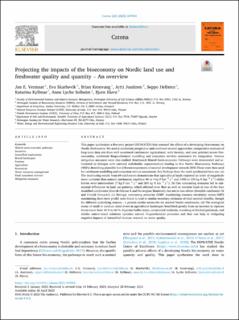| dc.contributor.author | Vermaat, Jan | |
| dc.contributor.author | Skarbøvik, Eva | |
| dc.contributor.author | Kronvang, Brian | |
| dc.contributor.author | Juutinen, Artti | |
| dc.contributor.author | Hellsten, Seppo | |
| dc.contributor.author | Kyllmar, Katarina | |
| dc.contributor.author | Solheim, Anne Lyche | |
| dc.contributor.author | Kløve, Bjørn | |
| dc.date.accessioned | 2023-09-21T13:46:11Z | |
| dc.date.available | 2023-09-21T13:46:11Z | |
| dc.date.created | 2023-05-04T12:23:39Z | |
| dc.date.issued | 2023 | |
| dc.identifier.citation | CATENA. 2023, 228, 107054. | en_US |
| dc.identifier.issn | 0341-8162 | |
| dc.identifier.uri | https://hdl.handle.net/11250/3091129 | |
| dc.description.abstract | This paper synthesizes a five-year project (BIOWATER) that assessed the effects of a developing bioeconomy on Nordic freshwaters. We used a catchment perspective and combined several approaches: comparative analyses of long-term data sets from well-monitored catchments (agricultural, with forestry, and near pristine) across Fennoscandia, catchment biogeochemical modelling and ecosystem services assessment for integration. Various mitigation measures were also studied. Benchmark Shared Socio-economic Pathways were downscaled and articulated in dialogue with national stakeholder representatives leading to five Nordic Bioeconomy Pathways (NBPs) describing plausible but different trajectories of societal development towards 2050.These were then used for catchment modelling and ecosystem service assessment. Key findings from the work synthesized here are: (a) The monitoring results from 69 catchments demonstrate that agricultural lands exported an order of magnitude more nutrients than natural catchments (medians 44 vs 4 kg P km−2 y-1 and 1450 vs 139 kg N km−2 y-1) whilst forests were intermediate (7 kg P km−2 y-1 and 200 kg N km−2 y-1). (b) Our contrasting scenarios led to substantial differences in land use patterns, which affected river flow as well as nutrient loads in two of the four modelled catchments (Danish Odense Å and Norwegian Skuterud), but not in two others (Swedish catchment C6 and Finnish Simojoki). (c) Strongly contrasting scenarios (NBP1 maximizing resource circularity versus NBP5 maximizing short-term profit) were found to lead to similar monetary estimates of total societal benefits, though for different underlying reasons – a pattern similar across the six studied Nordic catchments. (d) The ecological status of small to medium sized rivers in agricultural landscapes benefitted greatly from an increase in riparian forest cover from 10 % to 60 %. Riparian buffer strips, constructed wetlands, rewetting of ditched peatlands, and similar nature-based solutions optimize natural biogeochemical processes and thus can help in mitigating negative impacts of intensified biomass removal on water quality. | en_US |
| dc.language.iso | eng | en_US |
| dc.publisher | Elsevier | en_US |
| dc.rights | Attribution-NonCommercial-NoDerivatives 4.0 Internasjonal | * |
| dc.rights.uri | http://creativecommons.org/licenses/by-nc-nd/4.0/deed.no | * |
| dc.title | Projecting the impacts of the bioeconomy on Nordic land use and freshwater quality and quantity – An overview | en_US |
| dc.type | Peer reviewed | en_US |
| dc.type | Journal article | en_US |
| dc.description.version | publishedVersion | en_US |
| dc.rights.holder | © 2023 The Authors | en_US |
| dc.source.pagenumber | 8 | en_US |
| dc.source.volume | 228 | en_US |
| dc.source.journal | CATENA | en_US |
| dc.identifier.doi | 10.1016/j.catena.2023.107054 | |
| dc.identifier.cristin | 2145436 | |
| dc.source.articlenumber | 107054 | en_US |
| cristin.ispublished | true | |
| cristin.fulltext | original | |
| cristin.qualitycode | 1 | |

